Nippon Telegraph & Tel Bundle
How Does NTT Shape the Future of Global Communication?
Nippon Telegraph & Telephone (NTT), a global telecommunications leader, is at the forefront of digital transformation. With a reported 2.47% revenue growth to 13.70 trillion JPY in the fiscal year ending March 31, 2025, NTT demonstrates its robust market presence. This Japanese Telecom giant is not just surviving but thriving, constantly innovating with technologies like IOWN and AI.
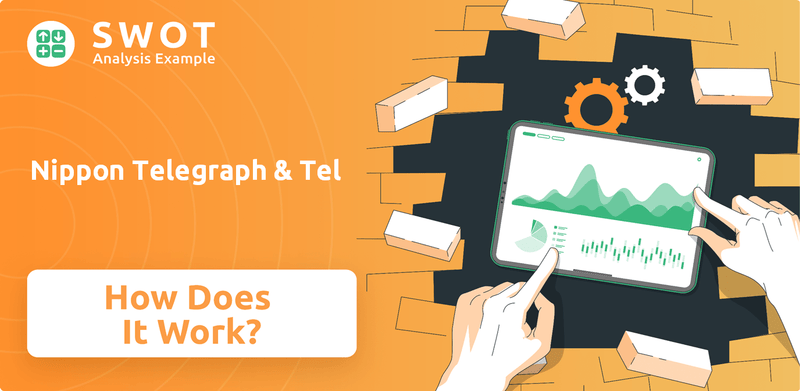
From its humble beginnings, NTT has evolved into a powerhouse, serving clients in over 80 countries. Understanding Nippon Telegraph & Tel SWOT Analysis is crucial for anyone seeking to understand the company's strategic positioning. Exploring how NTT operates its network infrastructure and its diverse service offerings provides invaluable insights into the company's global impact and future prospects. The NTT Group continues to be a pivotal player in the global economy.
What Are the Key Operations Driving Nippon Telegraph & Tel’s Success?
Nippon Telegraph & Telephone (NTT) delivers value through an integrated telecommunications approach, offering a wide array of services to both individual and corporate clients worldwide. Its core operations span fixed-line and mobile telephony, broadband, digital and internet television, and comprehensive IT and network services. The NTT Group leverages its extensive infrastructure and continuous technological advancements to maintain a competitive edge in the global market.
The company's value proposition lies in its ability to provide tailored solutions that enhance connectivity, offer advanced digital services, and provide robust IT infrastructure. This integrated model combines traditional telecom services with next-generation solutions, supported by a strong emphasis on research and development. This approach allows NTT to meet the evolving needs of its customers, driving benefits through enhanced digital experiences and operational efficiency.
Key subsidiaries like NTT Docomo manage mobile operations, serving 90.8 million subscribers in Japan, while NTT East and NTT West handle regional fixed-line services with approximately 23.6 million broadband lines. NTT Data and NTT Communications further extend its reach into system integration, cloud services, cybersecurity, and managed IT services, addressing complex business challenges worldwide.
NTT's core services include fixed-line and mobile telephony, broadband, and digital television. It also provides comprehensive IT and network services. These services cater to both individual consumers and corporate clients, ensuring a broad market reach.
NTT Docomo manages mobile operations, while NTT East and NTT West handle regional fixed-line services. NTT Data and NTT Communications focus on IT solutions and global services. These subsidiaries are crucial for NTT's diverse service offerings.
NTT invests heavily in R&D, focusing on 5G technologies, quantum cryptography, and photonics-electronics convergence. The company launched IOWN 2.0 in 2024, aiming for commercialization of photonics-electronics convergence (PEC) devices by 2026. This focus ensures NTT remains at the forefront of technological advancements.
NTT operates globally through its subsidiaries and extensive partnerships. Its global data centers and cloud computing investments support digital transformation. This network allows NTT to provide end-to-end solutions to various industries.
NTT's unique approach combines traditional telecom services with next-generation solutions, supported by a strong emphasis on R&D. This integrated model allows NTT to provide tailored solutions, driving customer benefits through enhanced connectivity, advanced digital services, and robust IT infrastructure. For more details on the company's structure, check out Owners & Shareholders of Nippon Telegraph & Tel.
- Fixed-line and mobile telephony services.
- Broadband and digital television services.
- Comprehensive IT and network solutions.
- Strong focus on research and development.
Nippon Telegraph & Tel SWOT Analysis
- Complete SWOT Breakdown
- Fully Customizable
- Editable in Excel & Word
- Professional Formatting
- Investor-Ready Format
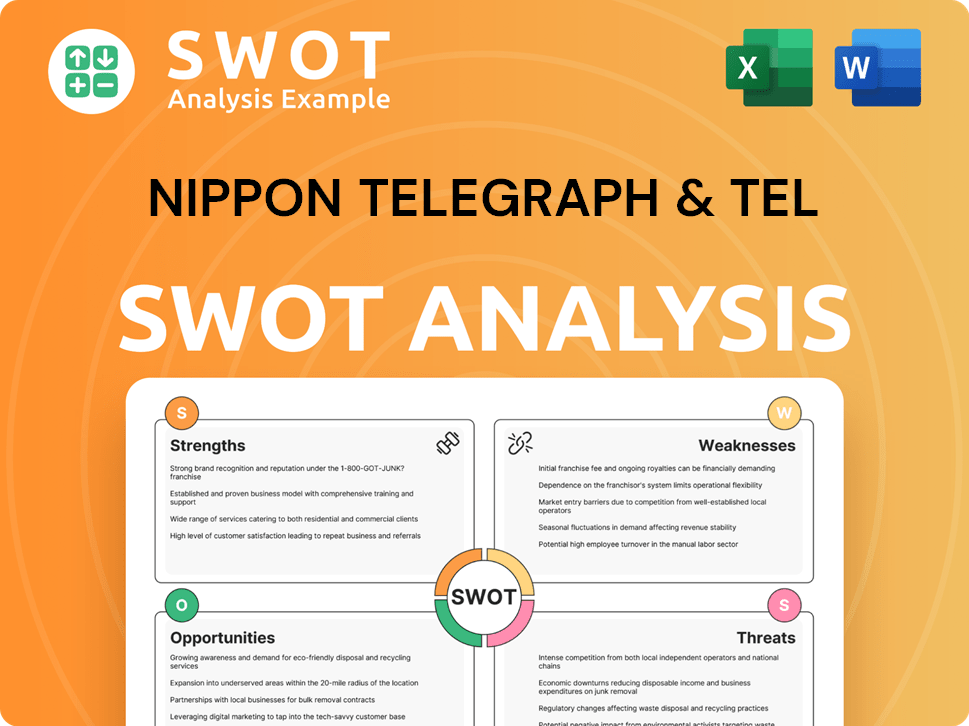
How Does Nippon Telegraph & Tel Make Money?
Nippon Telegraph & Telephone (NTT) generates revenue through a diverse set of services, reflecting its integrated telecommunications and IT model. The company's main revenue streams include fixed and mobile voice and data communication services, internet and network services, and system integration. For the fiscal year ending March 31, 2025, NTT reported operating revenues of 13,704.7 billion JPY, showing a 2.5% increase from the previous year.
The monetization strategies of NTT are multifaceted, with mobile phone services, primarily through NTT Docomo, being a significant contributor to operating profit, accounting for two-thirds of it. NTT also earns revenue from domestic inter-prefectural and international communications services. Solutions services, including managed IT, cloud, and cybersecurity, are also substantial contributors. Furthermore, through NTT Data and its subsidiaries, the company provides consultancy and system integration services globally.
NTT's revenue mix is diversified across its business segments and global operations. For example, NTT DATA Business Solutions AG, part of the NTT Group, reported a double-digit revenue growth of 14.7% to 1.85 billion euros for the fiscal year 2024/2025. This diversification ensures a steady income flow, enabling NTT to reinvest in cutting-edge technologies and infrastructure, thus maintaining its competitive edge. Recent changes include mobile price increases announced by NTT and KDDI, ranging from 5% to 15%, to offset inflation in the cost base, which are expected to improve the mobile business's performance. The company also plans to increase its cash flow through NTT Data's business and consolidate overlapping resources, along with cross-selling products.
NTT's financial success is rooted in a diversified approach to revenue generation and strategic monetization. This is evident from its significant operating revenues in 2025. The company's focus on innovation and expansion is further supported by its history, as detailed in Brief History of Nippon Telegraph & Tel.
- Mobile Services: Primarily through NTT Docomo, contributing a significant portion of operating profit.
- Fixed and Data Services: Revenue from domestic and international communications.
- Solutions Services: Managed IT, cloud, and cybersecurity solutions.
- System Integration: Consultancy and integration services provided by NTT Data and subsidiaries.
- Global Expansion: Revenue growth from international operations, such as NTT DATA Business Solutions AG.
Nippon Telegraph & Tel PESTLE Analysis
- Covers All 6 PESTLE Categories
- No Research Needed – Save Hours of Work
- Built by Experts, Trusted by Consultants
- Instant Download, Ready to Use
- 100% Editable, Fully Customizable
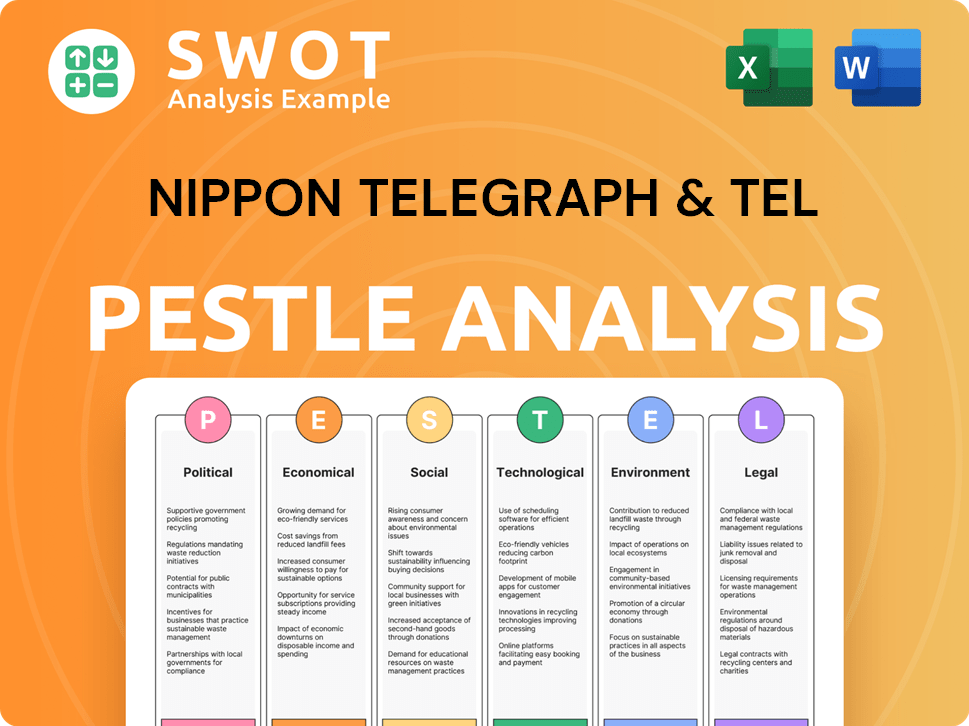
Which Strategic Decisions Have Shaped Nippon Telegraph & Tel’s Business Model?
Nippon Telegraph & Telephone (NTT) has significantly shaped the telecommunications landscape with strategic moves and technological advancements. The company's journey is marked by key milestones that have enhanced its operational capabilities and market position. NTT's commitment to innovation and strategic partnerships has fortified its competitive edge in the dynamic telecommunications sector.
A key aspect of NTT's strategy is its focus on technological innovation, particularly through the Innovative Optical and Wireless Network (IOWN) initiative. This initiative aims to enhance data transfer efficiency and reduce power consumption, with the All-Photonics Network (APN) already upgraded to guarantee bandwidth of up to 800 Gbit/s. Furthermore, NTT has expanded into new markets and strengthened its existing services through strategic partnerships and acquisitions.
NTT's evolution showcases its ability to adapt to market changes and maintain a strong competitive position. The company's integrated business model, which blends traditional telecommunications with next-generation solutions, allows it to provide tailored services and maintain a diversified revenue structure. This approach, combined with significant investments in research and development, ensures NTT's continued growth and leadership in the telecommunications industry. To learn more about the company's target market, check out this article: Target Market of Nippon Telegraph & Tel.
NTT launched IOWN 2.0 in 2024, expanding its scope from networks to computing, with commercialization of photonics-electronics convergence devices planned for 2026. The company developed an AI inference LSI chip for real-time AI processing of ultra-high-definition video. The All-Photonics Network (APN) has been upgraded to guarantee bandwidth of up to 800 Gbit/s.
NTT formed a joint venture with NTT Docomo in 2023 to enhance 5G network capabilities. The company expanded its product offering into the autonomous vehicle space through a partnership with May Mobility. NTT announced mobile price increases of 5% to 15% to mitigate rising costs.
NTT's strong brand value contributes to high customer loyalty and a significant market share, estimated at 30% in Japan's broadband market. The company boasts an extensive intellectual property portfolio with over 40,000 patents globally. NTT benefits from economies of scale derived from its vast network infrastructure and global operations.
NTT faced intense competition in its mobile business, leading to higher marketing costs and slightly lower average revenue per user. In response, the company announced mobile price increases of 5% to 15% in some cases, including bundled content, to mitigate the impact of rising costs.
NTT's commitment to innovation is evident in its IOWN initiative and the development of advanced AI chips. These technological advancements are crucial for maintaining a competitive edge in the rapidly evolving telecommunications market. NTT's strategic partnerships and integrated business model further enhance its ability to provide tailored services and maintain a diversified revenue structure.
- IOWN initiative focuses on photonics-electronics convergence devices for commercialization by 2026.
- NTT has a strong brand value and high customer loyalty.
- The company holds over 40,000 patents globally.
- NTT invests heavily in R&D, focusing on emerging technologies like AI, IoT, and sustainable digital infrastructure.
Nippon Telegraph & Tel Business Model Canvas
- Complete 9-Block Business Model Canvas
- Effortlessly Communicate Your Business Strategy
- Investor-Ready BMC Format
- 100% Editable and Customizable
- Clear and Structured Layout
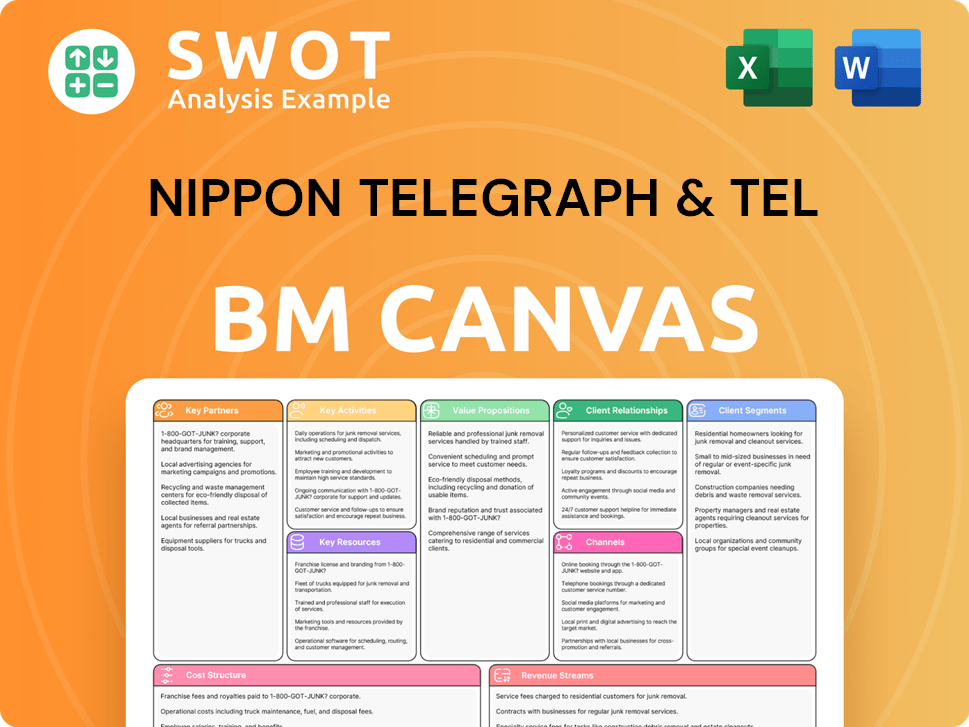
How Is Nippon Telegraph & Tel Positioning Itself for Continued Success?
Nippon Telegraph & Telephone (NTT) holds a prominent position in the global telecommunications landscape. As of the latest data, it ranks as the fourth-largest telecommunications company worldwide by revenue and the third-largest publicly traded company in Japan. Its strong market share in Japan, estimated at around 30% in the broadband sector, demonstrates its significant customer loyalty within its home market. NTT's extensive global reach, spanning over 190 locations across more than 80 countries and regions, allows it to serve a diverse clientele, including both individual consumers and corporate clients.
Despite its strong industry position, NTT faces various risks and challenges. These include regulatory changes within the telecommunications sector, intense competition from other global players, and potential technological disruptions. The mobile business, for example, has experienced competitive pressures, impacting its operating profit. Furthermore, evolving consumer preferences and the growing demand for digital transformation require continuous adaptation and investment to maintain its competitive edge.
NTT is a leading Japanese Telecom, ranking as the fourth-largest telecommunications company globally by revenue. It has a significant market share in Japan's broadband market and a global presence in over 80 countries.
NTT faces risks such as regulatory changes, intense competition, and technological disruptions. The mobile business specifically faces competitive pressure. Changing consumer preferences and the demand for digital transformation also pose challenges.
NTT is focused on strategic initiatives and innovation to sustain revenue growth. Key areas include the development of the Innovative Optical and Wireless Network (IOWN) and investments in AI and data center services.
For the fiscal year ending March 31, 2026, NTT forecasts operating revenues of 14,190.0 billion JPY. The company also aims to achieve net-zero emissions by 2030 for Scope 1 and 2, and by 2040 for Scope 1-3.
NTT is investing heavily in strategic initiatives and innovation to maintain and expand its revenue-generating capabilities. A core focus is on the development and deployment of the Innovative Optical and Wireless Network (IOWN), with IOWN 2.0 launched in 2024.
- The company is actively involved in AI research and development, including the creation of an Industry AI Cloud.
- NTT Data, a key subsidiary, is making significant investments in its data center business, increasing its service capacity by approximately 380 MW in FY2024.
- NTT is committed to sustainability, aiming for net-zero emissions by 2030 (Scopes 1 and 2) and 2040 (Scopes 1-3).
- The company plans further growth through targeted acquisitions, especially in key industries like life sciences and solutions based on SAP, Microsoft, or ServiceNow technologies. For further insights, read about Growth Strategy of Nippon Telegraph & Tel.
Nippon Telegraph & Tel Porter's Five Forces Analysis
- Covers All 5 Competitive Forces in Detail
- Structured for Consultants, Students, and Founders
- 100% Editable in Microsoft Word & Excel
- Instant Digital Download – Use Immediately
- Compatible with Mac & PC – Fully Unlocked
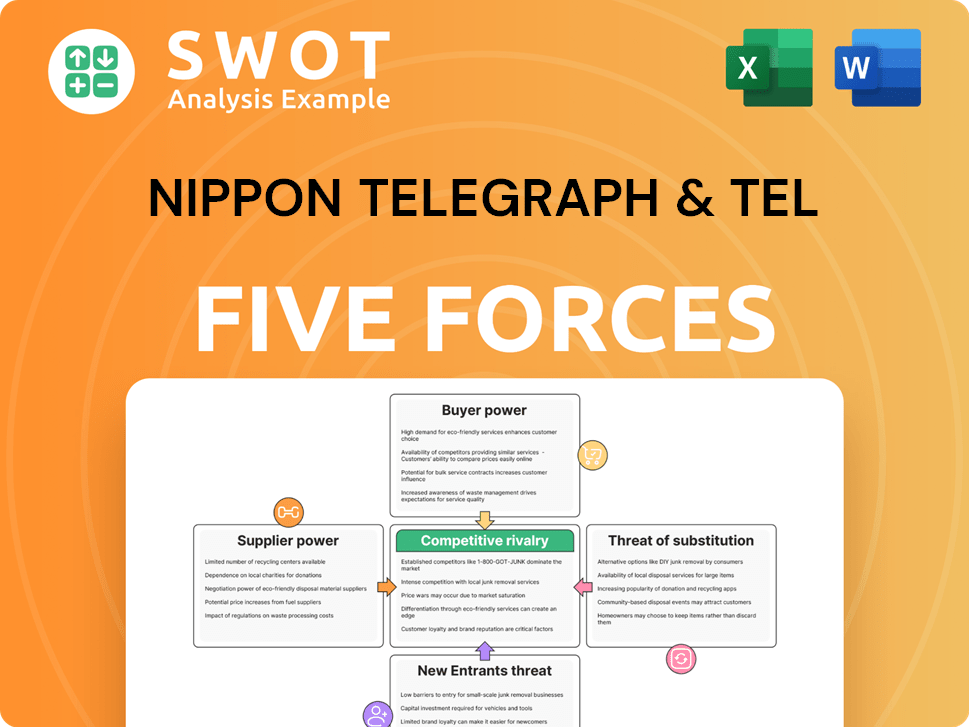
Related Blogs
- What are Mission Vision & Core Values of Nippon Telegraph & Tel Company?
- What is Competitive Landscape of Nippon Telegraph & Tel Company?
- What is Growth Strategy and Future Prospects of Nippon Telegraph & Tel Company?
- What is Sales and Marketing Strategy of Nippon Telegraph & Tel Company?
- What is Brief History of Nippon Telegraph & Tel Company?
- Who Owns Nippon Telegraph & Tel Company?
- What is Customer Demographics and Target Market of Nippon Telegraph & Tel Company?
Disclaimer
All information, articles, and product details provided on this website are for general informational and educational purposes only. We do not claim any ownership over, nor do we intend to infringe upon, any trademarks, copyrights, logos, brand names, or other intellectual property mentioned or depicted on this site. Such intellectual property remains the property of its respective owners, and any references here are made solely for identification or informational purposes, without implying any affiliation, endorsement, or partnership.
We make no representations or warranties, express or implied, regarding the accuracy, completeness, or suitability of any content or products presented. Nothing on this website should be construed as legal, tax, investment, financial, medical, or other professional advice. In addition, no part of this site—including articles or product references—constitutes a solicitation, recommendation, endorsement, advertisement, or offer to buy or sell any securities, franchises, or other financial instruments, particularly in jurisdictions where such activity would be unlawful.
All content is of a general nature and may not address the specific circumstances of any individual or entity. It is not a substitute for professional advice or services. Any actions you take based on the information provided here are strictly at your own risk. You accept full responsibility for any decisions or outcomes arising from your use of this website and agree to release us from any liability in connection with your use of, or reliance upon, the content or products found herein.